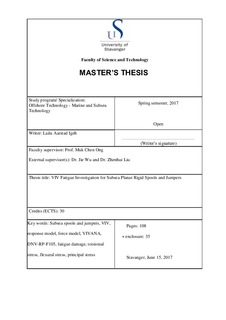| dc.description.abstract | Today, most new field developments consist of a subsea production system. Rigid spools and jumpers are important parts of these systems as they accommodate pipeline expansion and contraction due to changes in pressure and temperature, or due to movements of structural members. As rigid spools and jumpers are located near the sea bottom and normally consist of significant free spans, they could be subjected to seabed currents. These seabed currents, if large enough, can lead to vortex induced vibrations (VIV), which will lead to fast accumulation of fatigue damage. As failure of a rigid spool or jumper will have severe environmental and economic consequences, a proper fatigue assessment should be done to ensure sufficient fatigue life and avoid fatigue failure.
The complex geometry of rigid spools and jumpers means that the flow field and hence the vortex shedding will be complex. Currently, there are no proven design guideline or software available for assessing VIV response of a rigid spool/jumper. Moreover, the available design guidelines or software do not normally account for the torsional stiffness of the structure. Hence, they do not consider the fatigue damage due to torsional stresses. The objective of this study is to benchmark the prediction of the global response of a "M" shaped rigid jumper and investigate methods to account for torsional stress in fatigue analysis.
A validation study has been performed to evaluate the use of the semi-empirical program, i.e. VIVANA, and a response model approach based on DNV-RP-F105 (2006) to predict the VIV response of rigid spools and jumpers. These two VIV prediction approaches have been used to predict the VIV response of an “M” shaped rigid jumper exposed to varying current speeds hitting the jumper plane at two different angles. The two prediction methods have been evaluated against the existing experimental data.
When the current hits the jumper plane at a 10° angle, VIVANA seems to give fairly good predictions on the response frequency/mode and maximum displacement amplitude for most current speeds. The response model approach, on the other hand, seems to give large overpredictions of the displacement amplitude for most current speeds at this current direction. When the current has a 90° angle relative to the jumper plane, both VIVANA and the response model approach give good predictions with respect to the maximum jumper response.
iii
The results from the validation study are further used to calculate the fatigue damage of the rigid jumper. A methodology presented in Nair et al. (2011) is used to calculate the torsional stresses. This methodology is based on using the stress assessment method and the fatigue assessment method given in DNV-RP-F105 (2006), which originally is for stresses due to bending (i.e. flexural stresses), to also calculate the stresses due to torsion. Then the fatigue damage is calculated using two different methods. In method 1, the fatigue damage due to flexural stress ranges and the fatigue damage due torsional stress ranges are calculated separately. In method 2, the first principal stress range is used to calculated the fatigue damage.
For all current speeds and both current directions, method 2 gives higher fatigue damage for current velocities where the torsional stress contribution is large. Method 2 is also somewhat less time-consuming than method 1. | nb_NO |

